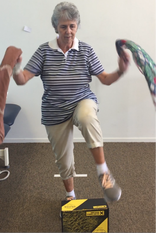 We all know it by now and if not you might have been under a rock, time and time again I have heard that exercise and being active is important. But I am active I hear you say…….. My answer to that is yes you maybe active but is it the right type of activity. People are 30% less active than their peers with Parkinson’s. Research indicates that at diagnosis a person with Parkinson’s is 30 % less active than that of age matched peers 1. And merely being active is not enough, the activity needs to be neuro active. When it is neuro active then you change your brain. A walk around the block will not be enough to change your brain. We talk about seven key principles that guide a neuro active exercise program. These are what we use to guide our treatments. These principles are based on the evidence of experience based plasticity2 which has been shown to change the brain and for Parkinson’s this has the potential to slow disease progression and help you move easier. The seven principles are: Amplitude – Move big, move with intention to create larger movements as normal movements in Parkinson’s are undersized. By moving BIG you are creating normal sized movements. Power – Moving Strong, move with intention to create force and power behind even the smallest movement with help create normal movements. Think brushing your teeth or pulling on your socks. High Intensity – Moving at 80 % of your maximum effort helps drive the change needed to change your brain. Complexity – Now this is where it gets interesting, by combining more than one task you help cement these changes in your brain. Think walking and saying the alphabet backwards or doing your times tables while cycling ( just watch the traffic if you are on the road) throwing a ball to your grand kids while standing on one leg, reciting your favorite poem while cooking dinner. Daily – Unfortunately your Parkinson’s does not take a break so its up to you to move daily with intention and in the correct manner that is going to make the changes and continue to see you have a long and happy life. Exercise and activity is as important as taking your medication and needs to be a non-negotiable part of your day. It also needs to be that you are moving in a deliberate manner every time you move. The best thing is the more you do this the less you will have to make yourself move in the correct way it will become habit. Fun – Choosing a fitness activity that you enjoy insures that you stick with your program, once you have learnt the principles as described here, as long as you move with intention you can adapt any activity to make it work for you, if you need to be doing something everyday you at least need to enjoy it. Specificity – We all know that Parkinson’s takes on many forms and no two people experience it the same way. Having an exercise program that focus’s on your main issues is what will make the difference for you. It maybe focusing on amplitude for Bradykinesia (small movements), High Intensity for tremor, or complexity for those newly diagnosed. Moving in a deliberate manner throughout the day at all times helps you fight Parkinson’s Learning how to use these principles is important. As well as education and teaching the principles when you see a physiotherapist that has expert training in Parkinson’s disease, they will be able to identify the key areas that you need to work on to make your life easier. They will set you an independent program that motivates and excites you. Teach you how to move correctly and effectively. And not to mention helps you fight back against your Parkinson’s. For further information check out our website at www.hibiscusneurorehab.co.nz 1 Ellis T & Motl R (2013) Physical activity behavioural changes in persons with neurological disorders: overview examples from Parkinson disease and multiple sclerosis JNPT 37:85-90. 2 Kliem JA & Jones TA (2008) Principles of experience-dependent neural plasticity: Implications for rehabilitation after brain damage. Journal of speech, language and Hearing research 51:S225-S239 |
�
Categories
All
Archives
July 2023
|
|
Contact Us
Give us a call or send us an email to find out how we can help you on your rehab journey Phone 09 424 3254 [email protected] Visit us 3/55 Karepiro Drive, Stanmore Bay, Whangaparaoa |
Cancellation Policy:
Out of courtesy to your therapist, and other clients who may be waiting for an appointment, please inform us of cancellations as soon as possible.
Cancellations Charges: Short notice cancellations within 48 hours of your appointment or reschedules will incur a late cancellation fee of 60%.
For block bookings, one session will be deducted for three cancelled appointments.
Please be aware that ACC does not cover all cancelled appointments.
How to Cancel Your Appointment
If you need to cancel your appointment, please call us at 09 424 3254 between the hours of 8am – 5pm. If necessary, you may leave a detailed voicemail message. We will return your call as soon as possible.
Late Cancellations/No-Shows
A cancellation is considered late when the appointment is cancelled less than 48 hours before the appointed time. A no-show is when a patient misses an appointment without cancelling. In either case, we will charge the patient a 60% missed appointment fee.
Out of courtesy to your therapist, and other clients who may be waiting for an appointment, please inform us of cancellations as soon as possible.
Cancellations Charges: Short notice cancellations within 48 hours of your appointment or reschedules will incur a late cancellation fee of 60%.
For block bookings, one session will be deducted for three cancelled appointments.
Please be aware that ACC does not cover all cancelled appointments.
How to Cancel Your Appointment
If you need to cancel your appointment, please call us at 09 424 3254 between the hours of 8am – 5pm. If necessary, you may leave a detailed voicemail message. We will return your call as soon as possible.
Late Cancellations/No-Shows
A cancellation is considered late when the appointment is cancelled less than 48 hours before the appointed time. A no-show is when a patient misses an appointment without cancelling. In either case, we will charge the patient a 60% missed appointment fee.

 RSS Feed
RSS Feed
